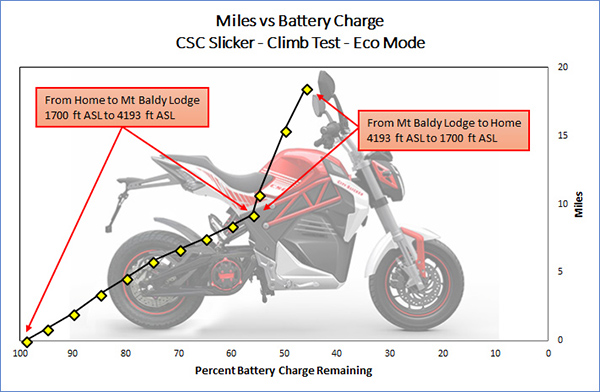
Phase III (pardon the electrical pun) of our City Slicker testing involved riding Slick from my home up to Mt. Baldy Village. It’s a 2,500-foot climb over 9.2 miles, and it’s rough. It’s a challenging climb on a small IC-engined motorcycle, and it’s really, really rough on a bicycle (as I know from personal experience). I knew power consumption would be higher based on our Phase I and II testing (see those results here and here), but the earlier tests did not include steep climbs. Phase III was a fairly steep uphill climb all the way, and then a steep descent all the way down. Here’s the route I took, up and down…

I didn’t know how Slick would do, and I didn’t want to run the bike down more than 50% (you know, to make sure I had the juice to get home). I decided in advance that if the bike hit the 50% energy remaining mark on the way up, I’d turn around and head back.
I need not have worried, though. I sailed up to the Mt. Baldy Lodge (that first photo you see above) with 56% power remaining on the charge indicator. I stopped to take a picture, and then I turned around and rode home. Here’s what it looks like on a miles versus battery charge plot…

As you can see from the above chart, energy consumption on the way down was near zero. I used 43% of the battery’s energy (from 99% to 56%) to make the 9.2-mile, 2500-ft-elevation climb, and then I used only 10% of the battery’s energy (from 56% to 46%) to cover the same distance riding downhill. Cool.
I ran this test in the Eco mode, mostly because I didn’t want to use too much energy on the climb. In the Eco mode on flat ground, the bike tops out at an indicated 37 mph (don’t forget that the speedometer is about 8-10% fast, so actual speed is lower). On the climb, Slick slowed to an indicated 33 to 34 mph on the steepest hills, which is about what my 150cc CSC Mustang could manage.
On the way down the mountain, Slick ran 43-44 mph (still in the Eco mode), and the throttle became meaningless. The bike coasted downhill faster than the motor could drive it. It reminded me of my bicycle down this same stretch. On my bicycle, I topped out at the same speed and pedaling was useless because my Bianchi was already going faster than I could pedal.
Watching Slick’s regeneration function on the dash was cool. The red regen plug (to the left of the battery charge indicator) stayed red for most of the run downhill. I previously wondered if the bike only regenerated at lower speeds; I now know it regens at all speeds when Slick is going faster than the motor is driving it. Just like before, though, I never saw the charge percentage indicator go up (say, from 48% to 49%). It just stayed at a given percentage for a much longer time. I asked the wizards at Zongshen about this, and they confirmed it’s what they would expect.
The knee in the x-y plot at the 56% charge level is where I turned around (at the Mt. Baldy Lodge). It shows that Slick uses way less energy going downhill than it does going uphill. Like they say…duh. The slight changes in the slope of each line (for the uphill section, and then for the downhill section) are due to changes in the grade on Mt. Baldy Road. There were undulations in the road, and that’s why there are minor variances in the slope of the line on both the uphill and downhill portions of the graph.
Once I was home, I put Slick back on the charger for the ride back to CSC. I’m headed out on a road trip next week, and I wanted to return the bike to Steve.
I did the climb up to Mt. Baldy with the lights off. My bike is a preproduction sample, and it’s not wired to keep the lights on. The production City Slickers will have the LED marker lights on all the time(that’s a US requirement). The LEDs will consume a little energy, so the range will be somewhat less for the US bikes than what I’ve been reporting.
To get a feel for what the impact of having the lights on might be, when I returned the bike to CSC I rode there with the headlight and taillight on. This is a more severe test than would be running the bike with only the LED lights (the headlight and taillight consumes more energy than the LEDs). Previously, without the lights on the 16.4-mile ride to CSC from my home took 35% of the battery’s charge. Running the same route today with the headlight and taillight on, I used 42% of the battery’s energy. Note that this is more energy than would be consumed with just the LEDs (but it is representative of energy consumption when riding the bike at night). And, I was hotfooting it a bit. I wanted to stay at around 34-35 mph, but Slick was smelling the barn and I frequently ran faster than that.
So there you have it. Eco mode, Power mode, and a steep climb and descent on the CSC City Slicker. Stay tuned; there’s more coming on this fascinating new electric motorcycle. You’ll see it here first.
